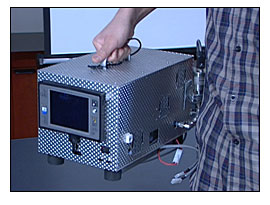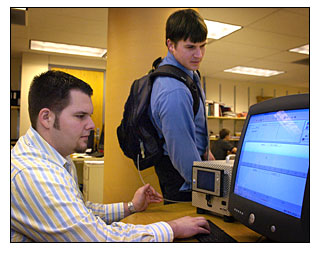WEST LAFAYETTE, Ind., March 20, 2006 -- Purdue University researchers have developed a new, portable ultrafast chemical analysis system with potential applications ranging from sniffing luggage for explosive residues to detecting molecular disease markers in urine samples.
The researchers also recently demonstrated that their system can rapidly and accurately detect the boundary between cancerous and healthy liver tissue -- information that could help surgeons ensure they remove the entire tumor and spare normal tissue.

Researchers at Purdue University have created a miniature mass spectrometer that has potential applications ranging from airport security to medical diagnostics. This latest prototype, the Mini 10 portable mass spectrometer, is roughly the size of a shoebox and can be carried with one hand. The instrument is 13.5 in. long, 8.5 in. wide and 7.5 in. tall and weighs 22 lb, or 30 times less than a conventional mass spectrometer. It can also run on batteries. (Photo: National Science Foundation)
"I wouldn't be surprised if pathologists are using this in operating rooms within two years," said Purdue's R. Graham Cooks, the analytical chemist who heads the research effort.
Mass spectrometry works by first turning molecules into ions, or electrically charged versions of themselves, which can be detected and analyzed. Conventional mass spectrometers analyze samples that are specially prepared and placed in a vacuum chamber. The key innovation developed at Purdue is performing the ionization step in the air or directly on surfaces outside of the mass spectrometer's vacuum chamber.
The team's overall goal has been to speed up and simplify the use of the mass spectrometer, an analytical device that has been a laboratory fixture since its invention over 100 years ago. In earlier work, the team tackled the large size, handling difficulties and expense of conventional mass spectrometers. Those efforts resulted in a portable, shoebox-sized instrument that weighs just 22 pounds (10 kg) in its current version, or about 30 times less than a conventional mass spectrometer. Moreover, that weight includes a battery pack that allows the instrument to be carried into the field to reach the sample, rather than bringing the sample to the lab.

Purdue University doctoral student Christopher Mulligan uses a desorption electrospray ionization (DESI) tube to scan the outside of a backpack worn by Adam Keil, a postdoctoral research associate. The spray knocks molecules off the pack's surface, which are then analyzed by the Mini 10 portable spectrometer. (Photo: David Umberger, Purdue News Service)
The Purdue team has addressed the limitation that conventional mass spectrometers can analyze only samples that have been specially prepared. Their solution is a wand-like probe that can quickly gather chemical information from ordinary samples out in the open air. Based on a process known as desorption electrospray ionization, or DESI, the probe will essentially blast the molecules off any available surface using a mist of microscopic, ionized water droplets. DESI has been used to accurately detect cancer in human livers and pinpoint the boundaries of tumors. The researchers used the device to analyze slices of liver and other tissues removed in biopsies.
"The theme in our lab is, 'Don't mess with chemicals,' meaning we don't undertake the usual chemical separations and manipulations needed for conventional mass spectrometry," said Cooks.
DESI promises to be an important "high-throughput" tool to collect large amounts of data used in "metabolomics," a field in which researchers search for chemical compounds called biomarkers. These biomarkers are early warnings of disease, but they can be difficult to spot among the hundreds of distinct chemicals normally present in the urine, blood or serum of healthy people. The DESI experiment allows testing to be done without separating the compounds of interest from biological fluids, Cooks said.
"For example, we can place a small drop of urine on filter paper and then test the samples, recording a mass spectrum, which gives all the components of the urine," Cooks said. "Then we identify the individual components in another quick step.
"This two-step procedure, which is known as tandem mass spectrometry, allows us to rapidly confirm the presence of hundreds of components in a urine sample. If, for example, you were conducting medical research with animals and you were studying mouse urine samples, all the mice with a certain disease would show certain compounds in their urine — biomarkers that signal that particular disease state, and the collection of those biomarkers together would represent a common feature of a particular disease."
Currently, metabolomics is carried out using a technique called nuclear magnetic resonance. DESI, however, could be used to more quickly and accurately analyze a person's urine for the presence of diseases revealed by biomarkers, Cooks said.
The researchers also have used DESI to detect residues from explosives, and the recent paper about the technique includes a table showing various explosives the scientists have detected with DESI.
"We really don't know of any explosives that we can't detect," doctoral student Justin Wiseman said.
Cooks and his colleagues describe their work in the March 17 issue of the journal Science. The paper was written by Cooks, associate research scientist Zheng Ouyang, visiting scholar Zoltan Takats and Wiseman, all in Purdue's chemistry department. Several technical papers have been published about DESI experiments since the method was announced by the same lab in Science less than two years ago, the researchers said, but the new paper provides the first overall review of DESI and related techniques.
Much of the project's funding has been provided by the National Science Foundation and the Office of Naval Research, as well as by Inproteo LLC and its spin-off, Prosolia Inc., two Indiana companies that commercialize technology developed at Purdue. For more information, visit: www.purdue.edu